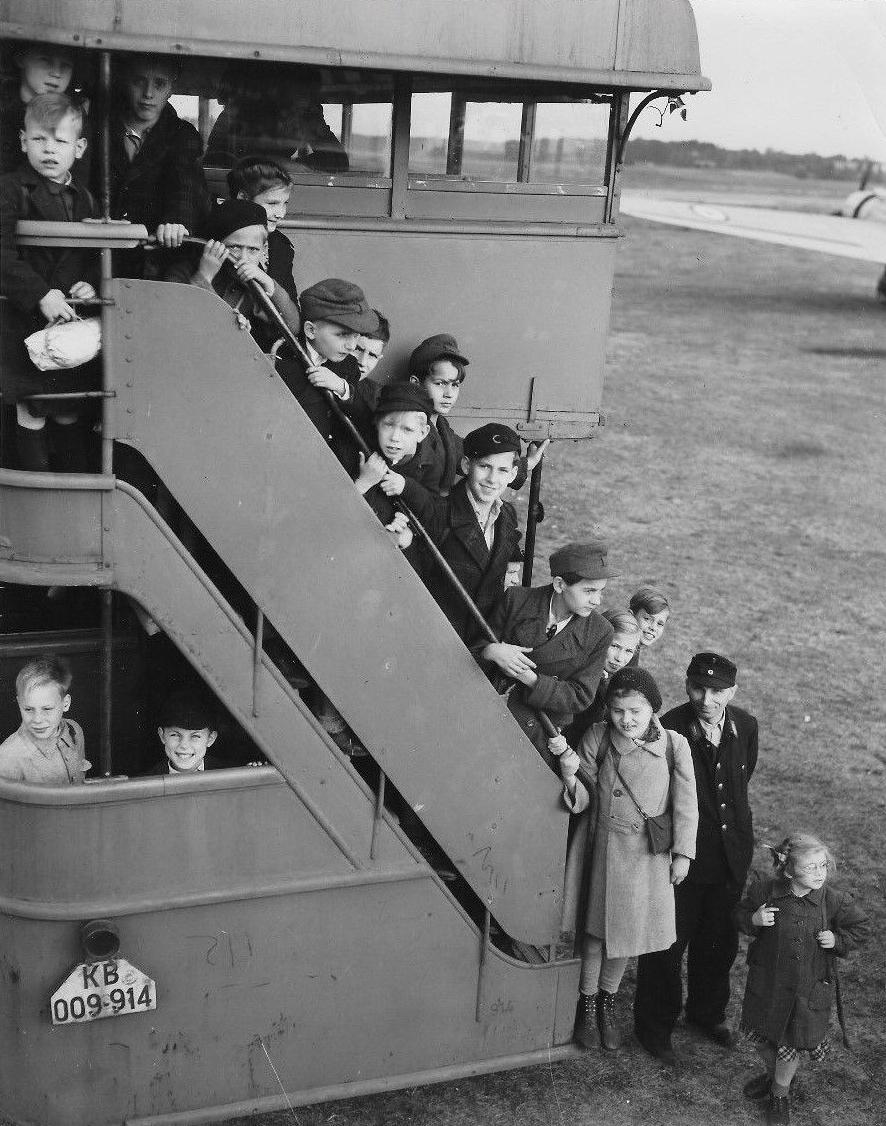
The Berlin Air Lift: Humanitarian Evacuations

Figure 1.--Stalin assumed that a huge city could not be supplied by air. The Luftwaffe's failure at Stalingrad must have been on his mind. Berliners and even Allied officials were also skeptical so West Berlin authorities decided to evacuate the most vulnerable. It was thought that supplies of food abd fuel wiuld drop percipitously during the winter because of the bad weather. The press caption here read, "Evacuated from Berlin for winter: A happy bus load of Berlin childrenwait their turn to board an RAF Dakota (C-47) for evacuation to Anerican and British zones where they will get adequate medical care and diet during the winter months. They were among first group to be flown out. Western authorities are planning to evacuate some 8,000 ill and undernourished children and old people, for the hard wintermonths." The photogrph was dated October 12, 1948. The photograph was probably taken from the RAF plane. You can see another RAF Dakota on the field at the upper right. The Air Lift was done with these C-47s which were small planes with limited capacity. The U.s. Air Force now had the larger four egine Douglas C-54 Skymaster in its inventory and many by the time this photograph was tsken were in Germany or on the way. The C-47 had been the main Allied transport in World war II. The much larger capacity C-54 was the a pivotal aircraft in the Berlin Airlift. Most of the children do not look all that happy to us. Actually we see a wide range of emotions. A few smiles, but mostly concern with being separated from their families and not knowing what to expect where they were headed. Photographer: Jol Schuppe.
|
|
There were huge shortages in Germany beginning in the last year of World War II. The worst were food and fuel shortahes. Germany was not self sufficent in food even before the war. Thus it needed food imports to survive. During the war, this had meant that German occupation authorities seized food from occupied areas creating severe food shortahes there. NAZI authorities also devised The Hunger Plan to kill unwanted people, most obviously Jews, but less well understood, other ethnic groups as well. Even before the War, as Allied armies liberated one country after anither, all of this ended. And the German people experienced the same food shortages that they had inflected on others. The countryside was not devestated like the cities, but the inability to obtain inputs (seed, fertilizer, equipment, livestock, ect.) impaired productivity. Even more imprtantly , the destruction of the German transport system meant that it was difficult to get food from the farms into the cities. All of this was just beginning to be solved by 1948 Occupation authorities obtained somr food from abroad, mostly America in the Western zones and the Soviet Union in the Eastern Zone. While no one starved, food rations were below what people wanted or that were optimal for a healty lifestyle. With the Soviet blockade, virtually all food and fuel deliveries to West Berlin were cut off. All of this was products delivered by road or rail. Air transport was very rare at the time and delivering food by air was seen as absurd. The same was true of coal, the principal fuel for generating electricity and for heating homes. The idea of supplying a huge city be air was thought to be unworkble. Almost certainly Stlin had in his mind the German attemps to supply Stalingrad by air. Thus in the autumn, Berlin authorities decided to evcuate some of the most vulnerable, sickly and undernourished children as well as the vulnerable elderly. We are not sure how the evacuees were chosen. Presumably it was done through doctors. It was thought that the healthy could withstand a cold winter and a cut in rations. But the vulnerable would be flown out in the returning transport aircraft. The Americans and Brirish offered to make the planes available for the evacuees. The plan was to evacuate some 8,000 people. If conditions worsened, more could be evacuated. But as the evacuations began the airlift began to kick in and deliveries steadily increased. The Allies demonstrated that they were able to deliver the food and fuel which Berlin needed by air. And they were able to maintain those deliveries even as the weather turned bad. Not only could West Berlin be supplied, but the availabilty of food in West Berlin surpssed that in unblockaded East Berlin.
CIH

Navigate the Children in History Website:
[Return to Main Berlin Air Lift Children page]
[Return to Main Berlin Air Lift page]
[Return to Main Cold War page]
[Return to Main Communism page]
[About Us]
[Introduction]
[Biographies]
[Chronology]
[Climatology]
[Clothing]
[Disease and Health]
[Economics]
[Freedom]
[Geography]
[History]
[Human Nature]
[Law]
[Nationalism]
[Presidents]
[Religion]
[Royalty]
[Science]
[Social Class]
[Bibliographies]
[Contributions]
[FAQs]
[Glossaries]
[Images]
[Links]
[Registration]
[Tools]
[Children in History Home]
Created: 9:40 AM 1/25/2016
Last updated: 9:40 AM 1/25/2016



